Looking for famous landmarks in Greece?
Greek landmarks are some of the most famous landmarks in Europe, from the most important archaeological sites to ancient settlements that take you back in time to the Ancient Greek city-states. These famous Greece landmarks spread from its capital city to the Greek islands and display Greece’s rich history.
This post may contain affiliate links, which means I may receive a commission, at no extra cost to you if you make a purchase through a link. Please see my full disclosure for further information.
Landmarks in Greece Map
List of Landmarks in Greece
- Mykonos Windmills
- The Blue Domes of Santorini
- White Tower of Thessaloniki
- Parthenon of Athens
- Ancient Agora of Athens
- Kastello Castle, Rhodes
- Temple of Poseidon, Cape Sounion, Athens
- Sanctuary of Delphi
- Shipwreck Beach, Zakynthos
- Blue Caves, Zakynthos
- Messailani Lake, Kefalonia
- Meteora
- Mount Olympus
- Mount Parnitha
- Samaria Gorge, Crete
- Petrified Forest, Lesbos
- Acheron River
- Dragon Lake
- Epidaurus Ancient Theatre, Argolis
- The Acropolis
- Mount Lycabettus
- Mycenae
- Palace of Knossos, Crete
- Temple of Olympian Zeus, Athens
- Ancient Olympia
- Ancient Corinth, Corinthia
Famous Greek Landmarks
These are some of the most famous Greek landmarks; ancient monuments and more modern landmarks in Greece alike. These most famous landmarks in Greece are some of the most interesting landmarks visited by tourists every year!
1. The Famous Mykonos Windmills
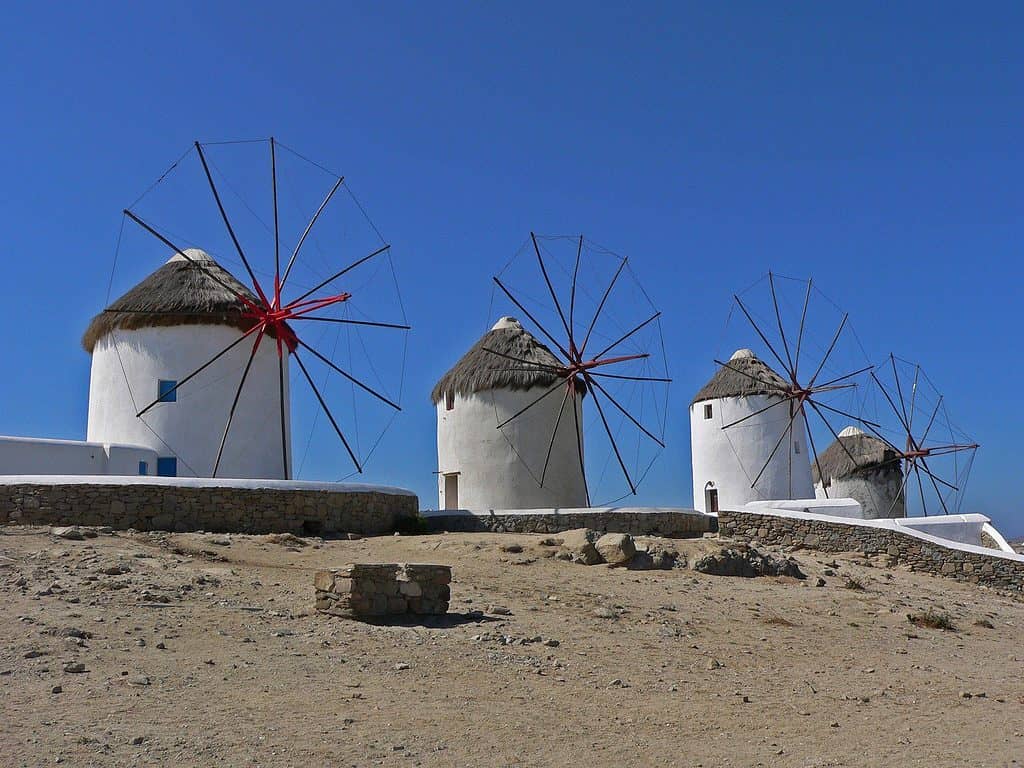
These astounding windmills are viewable no matter where you are on the Greek island of Mykonos’s main village, and they’re the first things you’ll see when sailing into Alefkandra harbour as they rest on the hill overlooking it.
Venetians built the seven major windmills on the hill in Chora from the 16th century until the 20th century, and they used to be a valuable local source of income. One has now been transformed into a museum!
The architecture is what makes them stand out amongst Greece landmarks. They are rounded and white with tiny windows and a pointed roof – a look now synonymous with Mykonos.
2. The Blue Domes (Cupolas) of Santorini

One of the most striking images commonly photographed of Greek island life is Santorini’s churches’ blue-domed roofs. This Greece landmark is found on postcards everywhere! The most famous churches are built on the slopes of calderas – collapsed magma chambers from the island’s volcanic formation – and their colours represent the Greek flag.
The churches of Agios Spiridonas and Anastasios in Oia are the most famous landmarks, but there are many others just like them on the island, one of which is now a museum. Don’t expect to be able to touch the blue domes, though – they’re strictly private property!
3. The White Tower of Thessaloniki
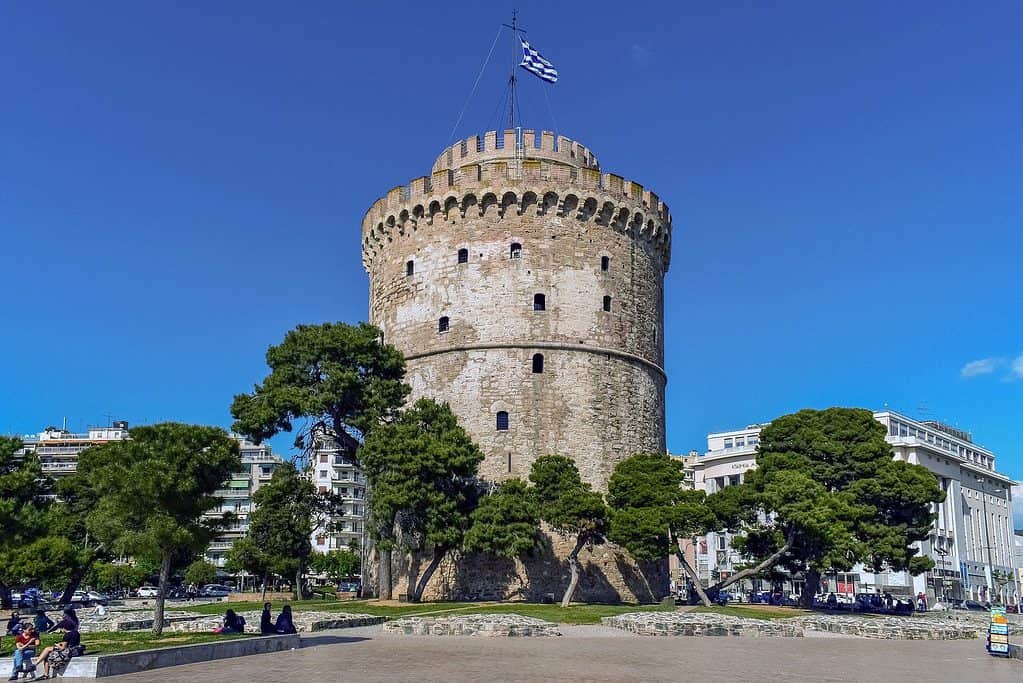
This is one of the landmarks of Greece located in Northern Greece, right on the waterfront of the major city of Thessaloniki. It’s both a monument and a museum of Greek history, and it has become a symbol of the city and of the region of Macedonia.
It was previously an Ottoman prison, named “the tower of blood” or “red tower”, but when Greece reclaimed it in 1890, it symbolically changed by being whitewashed into the White Tower we know today!
The museum explores Thessaloniki’s history right back to the Byzantine era and through the history of the old town to the present.
4. The Parthenon of Athens

The Parthenon – the Temple of Athena atop the Acropolis – is the most famous archaeological site in all of Greece and is a Greek landmark used to symbolise the country. It is filled with amazing sculptures that are high points of Greek art! The Athena Parthenos was the pride of the Parthenon – the gold and ivory statue had an entire chamber of the temple dedicated to it. Unfortunately, it was lost in the first millennium, but many other sculptures remain.
As it was in Central Greece, Ancient Athens was very important – and the Parthenon, dedicated to its namesake and patron Greek god, was just as essential. The Ancient Greeks took their gods very seriously!
5. The Ancient Agora of Athens

In Ancient Greece, an agora was a public gathering site that was used for markets, assemblies, meetings, socialising, business, politics, arts, and more.
The Ancient Agora of Athens has several intact or semi-intact monuments, including a temple of Ares, a 3rd-century synagogue, a temple of Aphrodite Urania, several shop-lined stoas, speakers platforms, altars, basilicas, and more. You can wander through these ruins and see them for yourself up close! In Athens, the most intact remains of an agora sit near the Acropolis on Agoraios Kolonos (Market Hill).
In the Stoa of Attalos within the Agora, a museum celebrates democracy and life in Athens through the years.
6. The Palace of the Grand Master of the Knights of Rhodes (Kastello)

This medieval castle is in the city of Rhodes on the island of the same name, semi-unique in Greece for its unusual Gothic architecture. The Order of Knights of the Hospital of Saint John of Jerusalem (or the Knights Hospitaller) was a religious, military order. After they occupied Rhodes, they built the castle to house their Grand Master.
The castle’s foundations were built on an ancient temple of Helios, the sun god -and may even have been the original site of the Colossus of Rhodes. Nowadays, quite a few important political meetings and treaties have been held there!
7. Temple of Poseidon, Cape Sounion

On Cape Sounion sits one of the most atmospheric Greek landmarks, the sister temple to the Parthenon of Athena – the Temple of Poseidon. Poseidon was the god and master of the sea and many other things! – and was therefore well-worshipped by the seafaring ancients. The archaeological site contained many terracottas, pottery, plaques, pieces of jewellery, and sculptures left from worship at the temple and in offering to Poseidon. There are also many figurines of horses, another domain of Poseidon. The ruins of an even more ancient temple sit underneath its foundations!
8. Sanctuary of Delphi
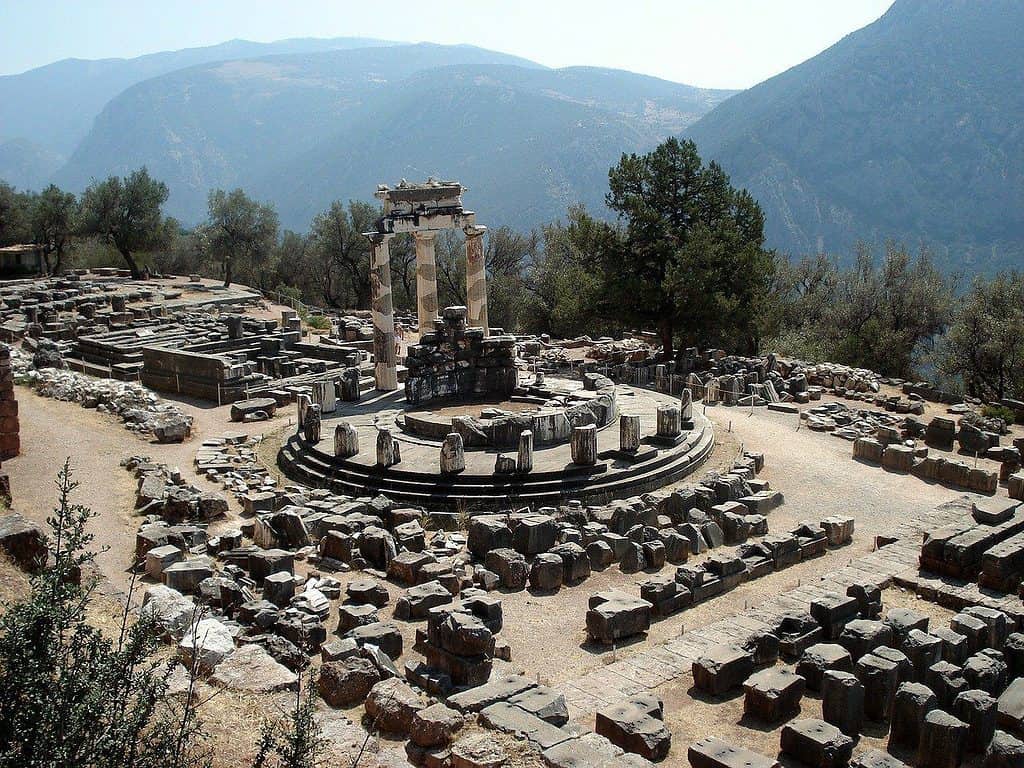
The old city of Delphi was the seat of the legendary oracle of mythology, and back then, the Greeks believed that the ancient town was the centre (or navel) of the world. It sits on the slopes of Mount Parnassos and is a huge site of archaeological interest within the Parnassus National Park. It’s also a World Heritage Site.
The most famous monument in Delphi by far is the Temple of Apollo, but many other features are just as impressive – the myriad treasuries where offerings were made, the altar of the Chians, the theatre, Sibyl Rock, and much, much more.
Most Famous Natural Landmarks in Greece
The natural beauty of Greece isn’t to be overestimated. From the Ionian Sea on the western coast to the Aegean Sea on the east coast, some of the most famous landmarks of Greece are so famous because of their natural contribution to Greek culture.
9. Shipwreck Beach, Zakynthos

The exposed cove of Shipwreck Beach (more properly called Navagio beach) on the Greek Island of Zakynthos was named the world’s best beach in 2018 and achieved fame after being featured in the Korean drama Descendants of the Sun, but neither of those is what makes it stand out so much!
The nickname comes from the wreck that sits abandoned in its centre. The MV Panagiotis was apparently smuggling contraband from Turkey when it ran aground on the 2nd of October 1980 – which might even have been a deliberate manoeuvre to escape the pursuing Navy! In any case, the shipwreck can still be visited to this day. One thing, though – you can only reach the beach by boat!
10. Blue Caves, Zakynthos
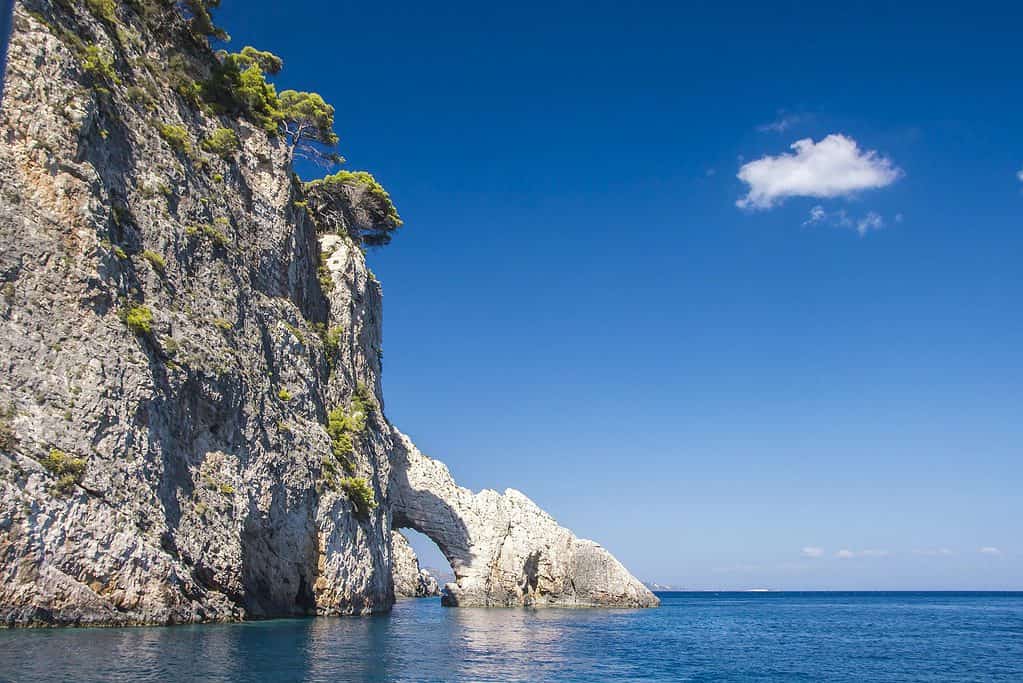
Zakynthos is a major Greek seaport, and no wonder – the sea around it is as stunning as all other Greece landmarks! The Blue Caves are a natural Greek monument to the island’s beauty.
The caves are only accessible by boat, and they reflect the stunning blue sea around them, giving them a distinct appearance unlike any other. As well as their stunning beauty, they’re an amazingly popular Greek landmark for diving enthusiasts!
11. Messilani Cave and Lake, Kefalonia

This lake-filled basin cave was known as the Cave of the Nymphs in ancient Greece, as it was where the daughters and wives of dogs were born in the ancient kingdom. The cave is surrounded by forests and mountain slopes and partly covered by brown rocks and plant life. In the large open space of the cave, however, you can look below and see the stunningly clear water with the rocky bottom of the cave. It’s so clear that things floating on it look like they are hovering off the ground!
12. Meteora, Thessaly
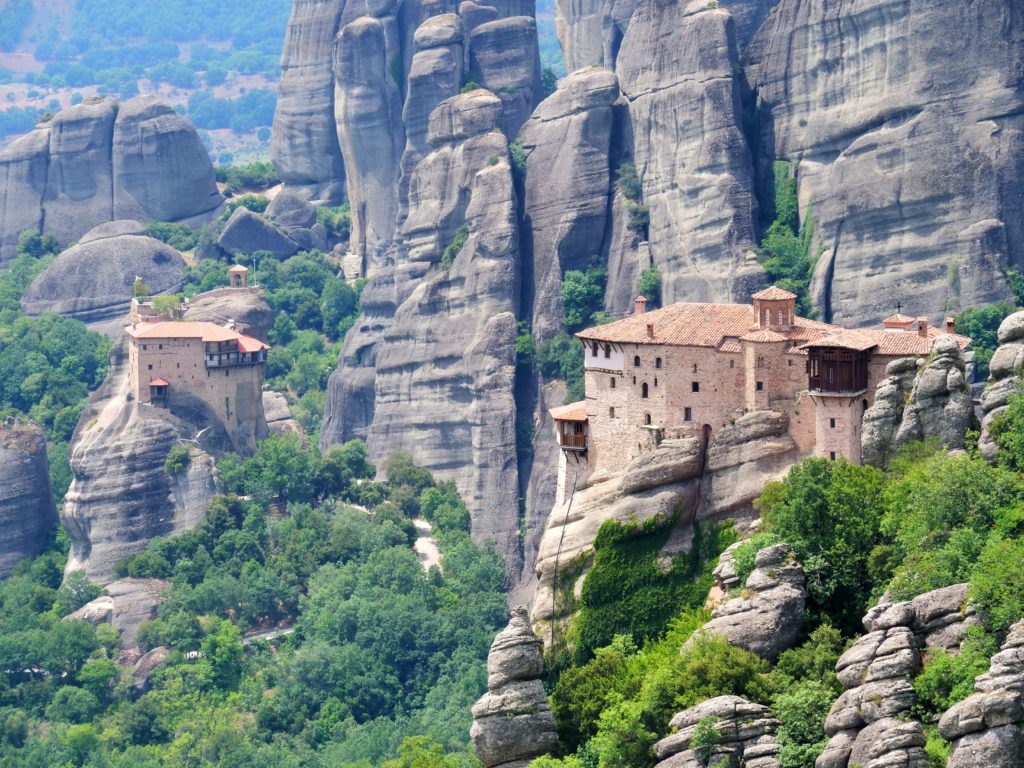
To call Meteora, a rock formation would be like calling a lion a cat – accurate, but nowhere near the whole picture! The huge rock columns tower over the area, and atop them sit the second-most-important Eastern Orthodox monasteries in Greece after Mount Athos. Six of these twenty-four monasteries have remained since the 13th century. Even before then, the rocks which touched the sky were places of worship for ancient peoples.
The caves around Meteora also serve as a valuable archaeological sites. The most significant is the cave of Theopetra, which contains records of when modern humans took over from Neanderthals and when farmers took over from hunter-gatherers.
13. Mount Olympus, Thessaly and Macedonia

There’s no way to write about Greek landmarks without paying homage to the home of the gods. Olympus is the tallest mountain. On its Mytikas Peak, the ancients believed that the ruling Olympian gods made their home, while several other gods and deities lived in other places around the mountain.
Besides its mythological associations, it’s a stunning mountain in its own right. It was the first national park to ever open in Greece in 1938, and it is so biodiverse that it is considered a World Biosphere Reserve for its flora and fauna! Besides all of that, it has been used as a sanctuary and base through wartime. The Greek civil war even started at its base!
14. Mount Parnitha, Athens

This mountain range, covered in beautiful forests and amazing wildlife, is a national park with several peaks to explore! As well as modern amenities like a cable car and casino, it has many points of interest to see. Red deer can be seen amongst over a thousand different flowers and plants amongst the trees.
Some of the manmade monuments to see include the Classical Era Phyle Fortress, the Pankaton, the Eleftrae fortress, and the Byzantine Monastery of Kleiston. The 19th century home of the Greek royal family, Tatoi Palace, is also there – but has been abandoned. Natural sights include Beletsi Lake, the Cave of Panas, and the Gorge of Gouras.
15. Samaria Gorge, Crete

The astounding gorge in Crete is a World Biosphere Reserve and a Greek National Park. It runs between the White Mountains and Mount Volakias and is about 16km long. At one point, called the Gates, the gorge closes to only four metres wide but three hundred metres high – quite intimidating for hikers! Before 1962, there was a village in the gorge, but it was abandoned when the park opened.
There are many rare wildlife to see, including the rare kri-kri, which only lives in one other place. Many tours leave from Chania to the park, and on the other end, which opens onto the sea, they get a ferry back to meet the bus home.
View Crete City Breaks:
16. Petrified Forest, Lesbos

Made up of the fossilised remains of trees and plants, this is a protected monument that contains more than 150 fossilised logs and a complete tree fossil that’s nearly 20 metres tall! It’s a protected national monument and has its natural history museum. The forest is a significant natural monument, not just in Greece but in the world – it is what gained Lesbos its original entry into the Global Geoparks Network, which exists to promote natural tourism!
Many other fossils and volcanic rocks can be found across Lesbos, the whole of which is now a designated Geopark, but the Petrified Forest is what started it all.
17. The Acheron River, Epirus

In mythology, the Acheron was the river across which Charon, the ferryman of the Underworld, would carry souls to the next life after death, a role it shared in later myths with the river Styx. It was one of five total rivers in the Underworld which represented a different aspect of death – Acheron (woe or souls), Styx (oaths), Pyriphlegethon (fire), Cocytus (lament), and Lethe (forgetfulness).
Despite its mythical status, the Acheron is a very real river that you can visit today! It flows through a village and lovely forested land right out to the sea.
18. Drakolimni (Dragon Lake(s)), Epirus

There are several Dragon Lakes in the mountains of Epirus, but the most famous are the ones on Mount Tymphi and Mount Smolikas. These are two of the tallest Greek mountains and are separated only by a river, and both have one of these stunning alpine lakes on top of them. The folktales of the area tell that each lake was once home to a dragon, and the dragons fought each other by throwing rocks and trees at each other.
The two lakes have a fascinating difference in appearance – the rocks surround the trees on one, and the trees surround the rocks on the other. As far as the folklore is concerned, that’s the dragons’ doing!
Famous Ancient Greek Landmarks
Greece’s famous landmarks are most often linked with the ancient world – and for a good reason! There’s enough history in Greece to fill more than one archaeological museum, but many ancient ruins still stand today, combining history and Greek mythology together into one famous landmark.
19. Epidaurus Ancient Theatre, Argolis

This Greek monument is considered one of the most perfect Ancient Greek landmarks we have. The theatre is so intact that it’s still used for performances right to this day, both by Greek and foreign artists and performers.
In Ancient Greece, the stunning theatre had another purpose – dramatic shows were supposed to be good for mental and physical health, so doctors would send their patients to see a show there!
When excavations of the archaeological site started in 1881, everyone was surprised by how well-preserved the theatre seemed to be. With some preservation efforts, the theatre as it exists now is almost entirely as it did in ancient history!
20. Acropolis, Athens
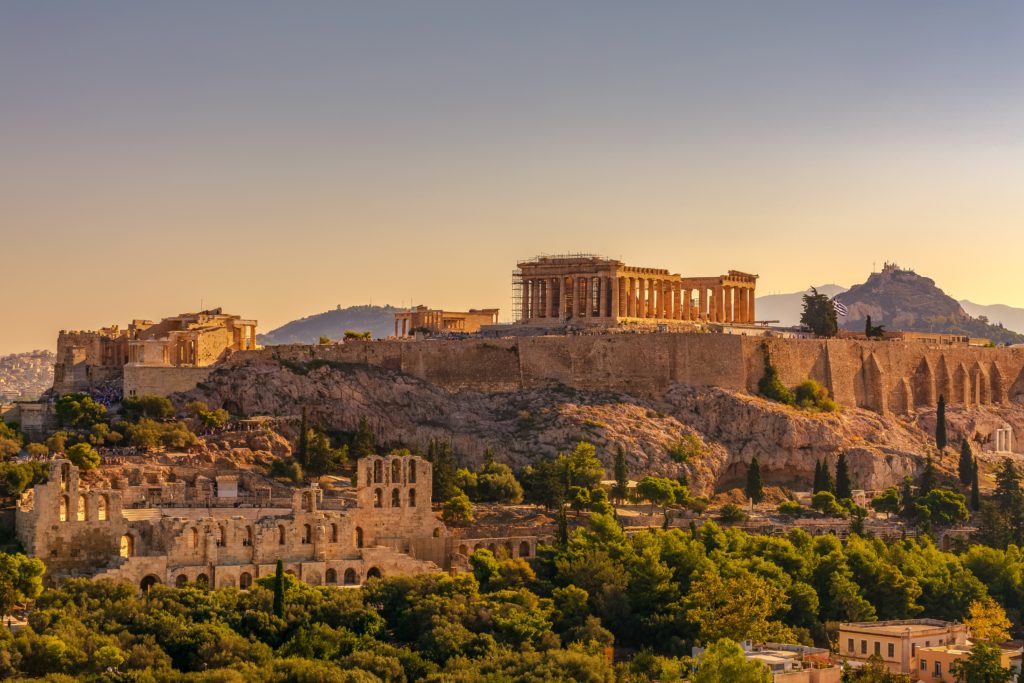
The Acropolis is known for being home to its most famous building, the Parthenon of Athena – but that’s only a fraction of what you can see there! Many archaeological sites cover the slopes of the hill where the citadel was built – 21 in total, all dedicated to the Greek gods. As well as the Parthenon, some include the Pandroseion, the Odeon of Pericles, the Chalkotheke, and the Theatre of Dionysus. There is also a Sanctuary of Asclepius, which was a place of healing.
The ancient city knew the Acropolis as Cecropia, named for the mythological first Athenian king, Cecrops. The Acropolis Museum, very close to the Parthenon at the top of the hill, is home to all of the impressive artefacts uncovered during the citadel’s excavations.
21. Mount Lycabettus, Athens

This limestone hill rises out of the centre of Athens into almost a perfectly symmetrical pyramid! Its base is surrounded by thick forest and is a popular tourist destination – you can get to the top through a funicular cable train car! It’s the highest point in Central Athens, and from the top, you can uniquely see the city. According to legend, the hill got there when Athena dropped it!
On top of the hill, you’ll find some surprising treats – a theatre and a restaurant! The amphitheatre has hosted some of the biggest names in performance, from Black Sabbath to Leonard Cohen to Iron Maiden! There’s also a 19th century chapel of St. George.
22. Mycenae, Argolis

The archaeological museum at Mycenae is a gateway to a renowned bronze age culture even before Ancient Athens as we know it. It was a major centre of civilisation from about 1600 to 1100 BCE. Nowadays, the landmark you can see is the citadel, and lower town remains.
The main entrance to the citadel was the 13th century Lion Gate, which nowadays is the only remaining Mycenaean monument we have that has survived the test of time. It’s also the only bronze age Greek motif monument found above ground, and it was famously described in Classical literature as a piece of their history, too!
23. Palace of Knossos, Crete
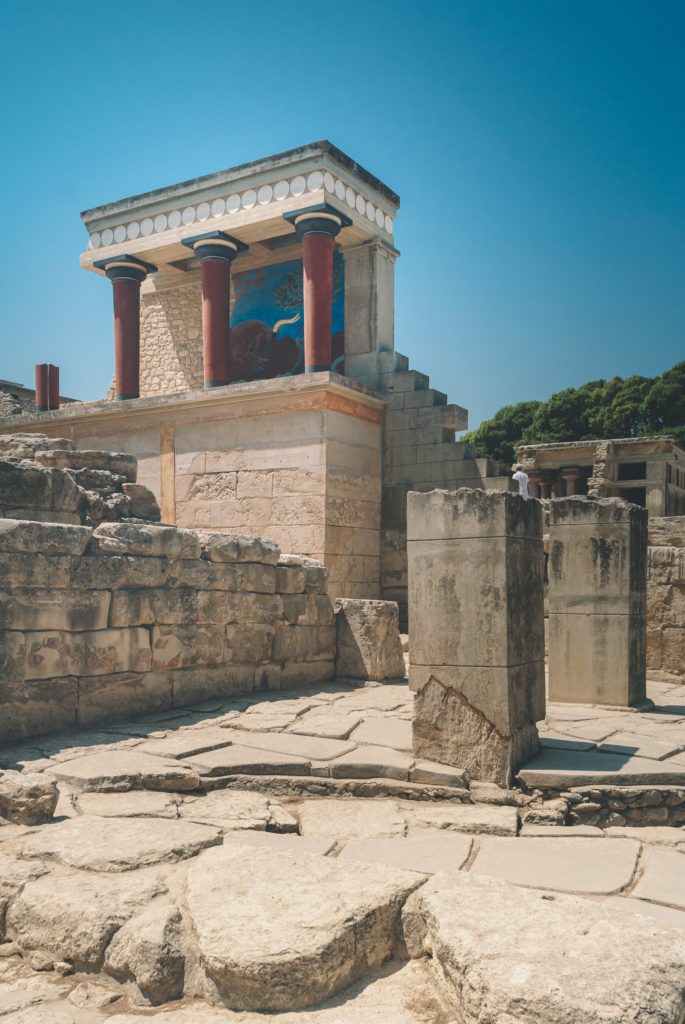
Knossos was the political and cultural centre of the Minoan civilisation, and the excavated site is known as the world’s oldest city. The palace was abandoned, and the city was destroyed around 1370 BCE, probably due to an act of war.
According to mythology, the legendary architect Daedelus built the palace and also built a maze – the great Labyrinth – to hold the king’s monstrous stepson, the half-bull Minotaur, who Theseus eventually slew. The ruins of the tower where Daedelus and his son Icarus were kept and the walls of the Labyrinth can still be explored today.
24. Temple of Olympian Zeus, Athens

The once-colossal Temple of Olympian Zeus is right at the centre of Athens and was dedicated to the king of the gods when the building project started in the 6th century BCE. Its architects dreamed of the greatest temple ever built, but it wasn’t finished for nearly 640 years! For some time, it was the largest temple in Greece and home to one of the biggest cult statues in the whole world.
After only a hundred years, though, a barbarian invasion destroyed the temple, and it was never repaired, and many of its materials were stripped away over the centuries to build around the city in other projects. Even then, sixteen of the original 104 columns still stand today!
25. Ancient Olympia, Elis

Unlike the modern Olympic Games, the Ancient Olympic Games were only held in one place; every four years at the religious sanctuary of Olympia, from 8 BCE to CE 4. Its name comes from its primary dedication to Zeus (and, to a lesser extent, the others in the Olympian ruling council). Still, it is nowhere near Mount Olympus is well over 310 miles away!
At the site of Olympia, there are the remains of more than 750 buildings. Some of the most significant include the Pelopion, the stadium, the village, and more. Three museums host movable artefacts, and the Kladeos River curls around the site.
26. Ancient Corinth, Corinthia

The original Ancient Corinth sits as one of the most well-known archaeological sites in the country. Every new excavation reveals something new about Greek history! The City-State of Corinth was about 3 miles southwest of the modern-day city.
At its height, it was one of the biggest and most populated Greek sites, with an impressive population of ninety thousand in 400 BCE. The Romans demolished it in 146 BCE, and they built the new city a hundred years later.
A few of the important monuments of the city you can still see are the Sacred Spring, the Sanctuary of Demeter and Kore (Persephone), and the Castle of Acrocorinth.
FAQ’s
Three famous Greek landmarks that hold an important place in Greece’s heart (other than the Acropolis/Parthenon, which is discussed below) are:
– Knossos Minoan Palace and the Labyrinth
– The White Tower of Thessaloniki
– The Blue-Domed Santorini Churches
The most famous of Greece landmarks is, of course, the Parthenon. The archaeological site dedicated to the Greek goddess Athena was a symbol of Ancient Athens and continues to represent the city and the country even today.
Though the Arcadian Temple of Apollo Epicurius at Bassae was the first recognised UNESCO World Heritage site and the most-well-preserved ancient site, the most well-known UNESCO site is the Acropolis. This ancient citadel contains many famous landmarks and is topped by the Parthenon.
Discover the Best of Europe
Best Cities in Europe to Visit with Kids
Best Theme Parks in Europe for Kids
Sylvie Simpson is the founder of European Cities with Kids. For the past 6 years, she has been travelling all over Europe whenever she has the chance, both solo, for work and with her daughter. Sylvie is on a mission to help people make the most of city breaks in Europe with kids and helps over 50,000 readers per month plan and make the most of their trips in Europe with kids.
